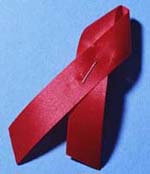HIV and AIDS
What is AIDS?
AIDS stands for acquired immunodeficiency syndrome. It is caused by the human immunodeficiency virus (HIV). This virus kills or impairs cells of the immune system. Over time, it destroys the body's ability to fight infections and certain cancers. HIV is most often spread by sexual contact with an infected partner.
AIDS refers to the most advanced stages of an HIV infection. HIV-infected people have AIDS if they have fewer than 200 CD4+ T cells. Healthy adults usually have CD4+ T-cell counts of around 600 or more. These T4 cells are key fighters in the immune system. HIV-infected people also have AIDS if they have one or more health conditions (including opportunistic infections and certain cancers) that affect people with advanced HIV.
The CDC estimates that 1.5 million adults and adolescents are living with HIV infection in the U.S. The HIV epidemic is getting under control in most parts of the world. That's because testing and treatment have become more available.
How is HIV transmitted?
|
Sexual contact |
|
HIV is spread most often by unprotected (without a condom) sexual contact with an infected person whose own HIV is not under control with treatment. The virus enters the body through the lining of the vagina, penis, or anus during sexual activity. Unprotected anal sex carries the highest risk of transmission. |
|
Blood contamination |
|
HIV may also be spread through contact with infected blood. But due to the screening of blood for HIV in the U.S., the risk of getting HIV from blood transfusions is very low. |
|
Needles |
|
HIV is often spread by sharing needles, syringes, or drug use equipment with someone who is infected with the virus and whose virus is not under control with treatment. Contaminated razors and other sharp devices (such as fingerstick machines) can also transmit HIV. Transmission from patient to healthcare worker, or vice-versa, through accidental sticks with contaminated needles or other medical tools is rare. |
|
Mother-infant |
|
HIV also can be spread to babies born to, or breastfed by, mothers infected with the virus, if the mother's HIV is not under control with treatment. |
|
HIV/AIDS cannot be spread through: |
|
What are the symptoms of HIV/AIDS?
Many people develop a flu-like illness within 2 to 6 weeks after exposure to the HIV virus. But about half do not get any symptoms at all when they first become infected. The symptoms that do appear often go away within a week to a month. Plus, they may be mistaken for some other illness. The symptoms may include:
-
Fever
-
Headache
-
Malaise
-
Enlarged lymph nodes
-
Rash
Lasting or severe symptoms may not start for 10 years or more after HIV first enters the body in adults. They may start within 2 years in children born with an HIV infection. This "asymptomatic" period of the infection is highly variable from person to person. But during this time, HIV is actively infecting and killing cells of the immune system. Its most obvious effect is a drop in the blood levels of CD4+ T cells. The virus initially disables or destroys these cells without causing symptoms.
As the immune system breaks down, complications start. The following are the most common complications, or symptoms, of HIV/AIDS. But each person may have different symptoms. They may include:
-
Lymph nodes that stay enlarged for more than 3 months
-
Lack of energy
-
Weight loss
-
Frequent fevers and sweats
-
Lasting or frequent yeast infections (oral or vaginal)
-
Lasting skin rashes or flaky skin
-
Recurrent diarrhea
-
Short-term memory loss
-
One or more infections (opportunistic infections) linked to having a weakened immune system. These include tuberculosis and certain types of pneumonia.
Some people have frequent and severe herpes infections. These may cause mouth, genital, or anal sores, or a painful nerve disease known as shingles. Children may have problems developing or fail to thrive.
During an HIV infection, most people have a gradual drop in the number of CD4+ T cells. Though some people may have abrupt and dramatic drops in their counts.
The symptoms of an HIV infection may look like other health problems. Always talk with your healthcare provider for a diagnosis. Rapid diagnostic tests are available and early diagnosis is important.
How is HIV/AIDS diagnosed?
Early HIV infection often causes no symptoms. It must be detected by testing a person's blood for antibodies—disease-fighting proteins—against HIV or by testing for the actual virus. Testing may not be positive until 2 to 12 weeks after infection. People exposed to HIV should be tested for the virus as soon as they think they may have been exposed to it.
If a person has been recently exposed or potentially exposed to HIV and initial testing is negative, repeat testing in 2 to 12 weeks will often be needed.
Treatment for HIV/AIDS
As with many other conditions, early detection offers better treatment. Antiviral medicines for HIV can stop the virus from further damaging the body. They can allow some or all of the damage to be healed. People who take these medicines can often live a normal life span and have a normal sex and family life.
There is currently no cure for HIV. But a person who takes antiviral medicines may be able to keep the virus completely under control. This is called "undetectable." Talk with your healthcare provider for more information about the excellent medicines available for treating HIV/AIDS.
Are we getting close to finding a vaccine for AIDS?
Billions of dollars are being spent each year to find a vaccine that might either prevent HIV infection or help the body to control the infection better. As of now, no vaccine has yet been shown to be effective enough to be used.



